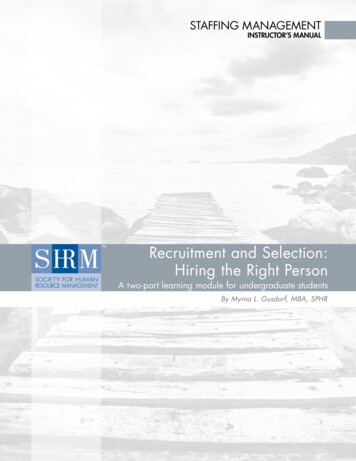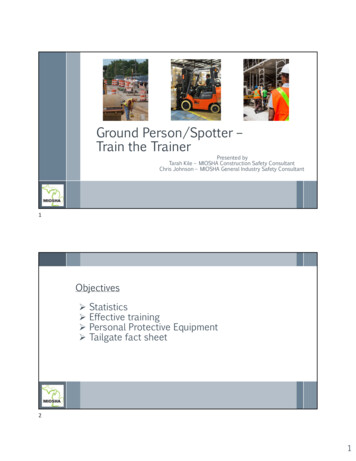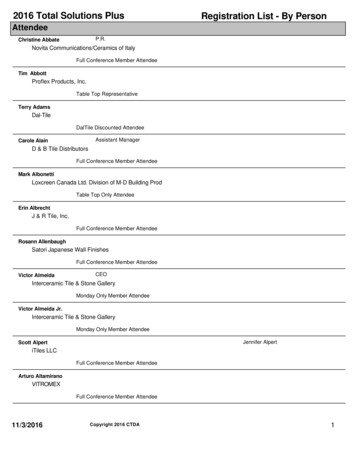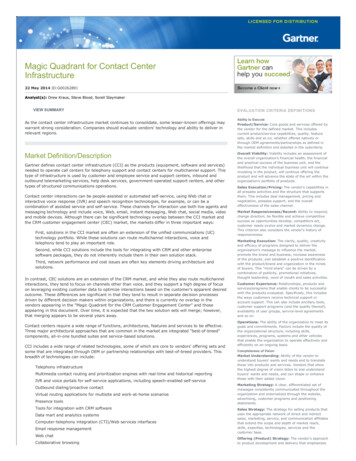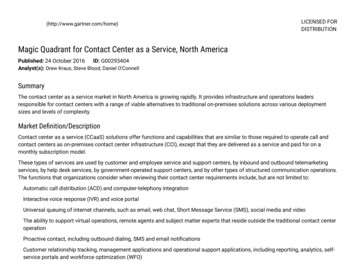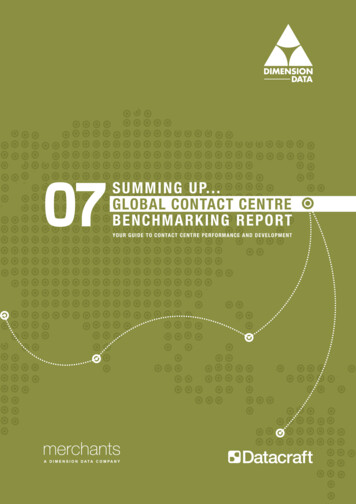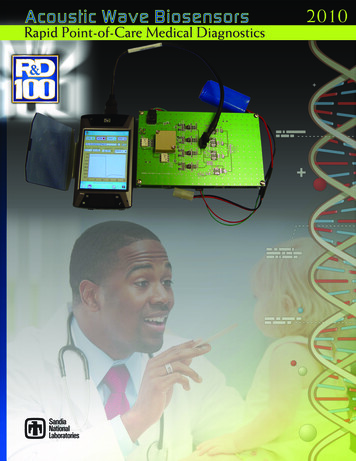
Transcription
R&D 100 EntrySubmitting OrganizationSandia National LaboratoriesP.O. Box 5800Albuquerque, NM 87185Susan BrozikAddress: P.O. Box 5800, MS 0892City/State: Albuquerque, NMZip/Postal Code: 87185Country: USAPhone: 505-844-5105Fax: 505-845-8161smbrozi@sandia.govContact PersonGlenn KubiakSandia National LaboratoriesDirector, Biological and Materials Science CenterAddress: 7011 East Avenue, MS 9405City/State: Livermore, CAZip/Postal Code: 94551Country: USAPhone: 925-294-3375Fax: 925-294-3403Email: kubiak@sandia.gov“ The collaborativepartnership of UNMand Sandia NationalLaboratories made thedevelopment of thissensor possible.”–Peter F. Bythrow, PhDNational MASINTManagement OfficeDefense IntelligenceAgencyJoint EntryUniversity of New Mexico Health Sciences CenterAddress: 1 University of New MexicoCity/State: Albuquerque, NMZip/Postal Code: 87131Country: USAContact Name: Richard Larson, MD, PhDPhone: 505-272-6950Fax: 505-272-5186rlarson@salud.unm.eduProduct NameAcoustic Wave Biosensors for Rapid Point-of-CareMedical Diagnostics2
Brief DescriptionThis technology is a handheld instrument that performs rapid,point-of-care medical diagnostic analyses of viruses, proteins,bacteria, and DNA with little or no sample preparation.Product First Marketed or Available for OrderThis technology became available for licensing in January 2009.Inventors or Principal DevelopersDeveloper Name: Susan Brozik, PhDPosition: Principal Member of Technical StaffOrganization: Sandia National LaboratoriesAddress: P.O. Box 5800, MS 0892City/State: Albuquerque, NMZip/Postal Code: 87185Country: USAPhone: 505-844-5105Fax: 505-845-8161Email: smbrozi@sandia.govDeveloper Name: Darren Branch, PhDPosition: Principal Member of Technical StaffOrganization: Sandia National LaboratoriesAddress: P.O. Box 5800, MS 1425City/State: Albuquerque, NMZip/Postal Code: 87185Country: USAPhone: 505-284-5843Fax: 505-844-1198Email: dwbranc@sandia.gov3
Developer Name: David Wheeler, PhDPosition: Principal Member of Technical StaffOrganization: Sandia National LaboratoriesAddress: P.O. Box 5800, MS 0892City/State: Albuquerque, NMZip/Postal Code: 87185Country: USAPhone: 505-844-6631Fax: 505-845-8161Email: drwheel@sandia.govDeveloper Name: Thayne Edwards, PhDPosition: Senior Member of Technical StaffOrganization: Sandia National LaboratoriesAddress: P.O. Box 5800, MS 0892City/State: Albuquerque, NMZip/Postal Code: 87185Country: USAPhone: 505-845-0467Fax: 505-845-8161Email: tledwar@sandia.govDeveloper Name: Richard Larson, MD, PhDPosition: Vice President for Translational Research, Sr. AssociateDean for ResearchOrganization: UNM Health Science CenterAddress: 1 University of New Mexico, MSC08 4640City/State: Albuquerque, NMZip/Postal Code: 87131Country: USAPhone: 505-272-6950Fax: 505-272-5186Email: rlarson@salud.unm.edu4
Developer Name: Brian Hjelle, MD, PhDPosition: Professor, School of Medicine, Pathology DepartmentOrganization: UNM Health Sciences CenterAddress: 1 University of New Mexico, MSC08 4640City/State: Albuquerque, NMZip/Postal Code: 87131Country: USAPhone: 505-272-4814Fax: 505-272-5186Email: bhjelle@salud.unm.eduDeveloper Name: David Brown, MSPosition: Health Sciences Research Specialist, School of Medicine,Pathology DepartmentOrganization: UNM Health Sciences CenterAddress: 1 University of New Mexico, MSC08 4640City/State: Albuquerque, NMZip/Postal Code: 87131Country: USAPhone: 505-272-3506Fax: 505-272-5186Email: dcbrown@salud.unm.eduDeveloper Name: Pam Hall, PhDPosition: Research Assistant Professor, Molecular GeneticsMicrobiologyOrganization: UNM Health Sciences CenterAddress: 1 University of New Mexico, MSC08 4660City/State: Albuquerque, NMZip/Postal Code: 87131Country: USAPhone: 505-272-4210Fax: 505-272-5186Email: phall@salud.unm.edu5
Developer Name: Marco Bisoffi, PhDPosition: Assistant Professor: Biochemistry Molecular BiologyOrganization: UNM Health Sciences CenterAddress: 1 University of New Mexico, MSC08 4670City/State: Albuquerque, NMZip/Postal Code: 87131Country: USAPhone: 505 272-8157Fax: 505-272-5186Email: mbisoffi@salud.unm.eduProduct PriceSandia National Laboratories (Sandia) and the University of NewMexico Health Sciences Center (UNM HSC) have entered intoan agreement with Adaptive Methods, Inc., to grant the latteran exclusive license in the subject technology. Led by AdaptiveMethods, Inc., the three organizations plan to commercialize thetechnology into a handheld device utilizing single-use disposablesensors, suitable for operation in a physician’s office.Anticipated pricing: nder 1000 for the base unit with standardULaptop/Desktop/PC interface and applicationsoftware.Less than 50 per disposable sensor (test).Patents or Patents PendingUS Patent Application #12/069284, February 8, 2008,DETECTION OF BIOAGENTS USING A SHEAR HORIZONTALSURFACE ACOUSTIC WAVE BIOSENSOR, February 8, 2008,Larson, Hjelle, Hall, Brown, Bisoffi, Brozik, Branch, Edwards, andWheeler.6
Product’s Primary FunctionWhat does it do? How does it do it?We have developed a handheld, battery-powered, portabledetection system that is capable of multiplex identificationof a wide range of medically relevant pathogens and theirbiomolecular signatures—viruses, bacteria, proteins, andDNA—at clinically relevant levels. This detection occurs withinminutes, not hours, at the point of care, whether that care is in aphysician’s office, a hospital bed, or at the scene of a biodefenseFigure 1: Acoustic wave biosensorinstrument with PDA controller andrechargeable battery. Sensor arrays fit inthe tan enclosure on the circuit board.or biomedical emergency. The Acoustic Wave Biosensor providesfast, low-cost diagnostic results with as good or better sensitivitythan traditional techniques.The technology is extremely versatile, useful in both biodefenseapplications and biomedical diagnostics. This system is capableof detecting biological pathogens in complex, real-worldenvironmental samples such as air, water, food, and soil. Thedetection system employs Sandia’s shear horizontal surfaceacoustic wave (SH-SAW) biosensor array functionalized withselective ligands—antibodies, peptides, or single-strand DNA,depending on the application. The SH-SAW sensor array acts as aminiature analytical balance, weighing the amount of pathogenbound to its surface by these ligands. One can think of theSH-SAW sensor as a spring with a small weight bouncing at oneend, with the ligands serving as an adhesive layer covering theweight. As the pathogens stick to the surface, the weight on thespring increases, which causes the speed of the spring’s bouncingto decrease. By measuring the speed of the bouncing, we candetermine how much of the pathogen has been captured. Whatmakes this a particularly useful sensor is that the SH-SAW candetect minute weight differences. In addition, the ligands arehighly selective, capable of distinguishing between closelyrelated pathogens.7
The sensor array is packaged in a disposable plastic cartridge thatis inserted by the user into the battery-powered electronics unit.In our current system, a drop of liquid—saliva, urine, or liquidextracted from a swab—is placed on the sensor input port. Dueto the package design, surface tension draws the sample overthe sensor, so no pumps or valves are required. The absence ofpumps and valves makes the sensor much smaller, more reliable,less expensive to manufacture, and extends the operating timeFigure 2 : Schematic of biosensorconstruction and function.of the rechargeable batteries. System control, data analysis, andreporting are performed by a personal digital assistant (PDA).Multiplex detection of different targets, up to six with our latestdesign, or orthogonal detection of a single target, enhancingdetection reliability, are both possible modes of operation.Advances in sensor design, made possible by Sandia’s proprietarysensor design software, are key to our ability to identify viruses atclinically relevant levels at the point of care, setting us apart fromcompeting technologies.Figure 3: Acoustic wave biosensorarrays with four sensors per device.8
Product’s CompetitorsCurrent approaches to the diagnostic detection of pathogensare relatively mature and have generated a wide range ofproducts. However, competing approaches can be classifiedinto several technological areas, including: bacterial cultures;viral cultures; polymerase chain reaction (PCR) for nucleicacid identification (genetic fingerprinting) of bacteria, viruses,and genetic disease; and enzyme immunoassays (EIA, bothcolorimetric and strip or swab assays) to detect pathogenprotein signatures and protein toxins. Of these approaches,bacterial and viral1 cultures, PCR2, and colorimetric3 EIA requirethe facilities in a regional medical laboratory and cannot beperformed at the point of care. Strip enzyme immunoassays(SIA), also known as lateral flow immunoassays, do providepoint-of-care diagnostic capability and are available from SilverLake Research Corporation4 and Oxoid, Ltd5. As shown in thefollowing comparison matrix, no existing product matches oursin performance in a point-of-care-setting.“ Having a hand-held sensor that canrapidly detect a varietyof analytes, includinginfectious agents, iscritical to ensure theintegrity of the bloodsupply and deliverpertinent care. Thistechnology promisesto deliver significantresults in this area.”–Jessie SalkPresident and CEO, TricoreReference Laboratories9
Comparison MatrixProduct/TechnologyVersatilitySizeAcoustic WaveBiosensorVirus, reBacteriaViral CultureSpeedSensitivitySpecificityEaseof UseUnitPriceCost pertestMinutesHigh:medicallyrelevantHighSimple, no 1,000additional (estimate)reagents ,additionalreagentsHigh:requireslab facility 50– 500VirusLaboratoryDays High:requireslab facility 50– tensivetraining,expensivereagentsHigh:requireslab facility 50– tensivetraining,additionalreagentsHigh:requireslab facility 1– 10SIAProteinsHandheldMinutesLowLowSimple 0– 25 1– 1010
How Product Improves on CompetitionAs shown in the comparison matrix, no near-competitorsexist for a handheld pathogen detector that enables a realtime diagnosis with little or no sample preparation. Thisconclusion is supported by market research performed byAdaptive Methods, Inc., the technology licensee, and by lettersof support from physicians and the president of a regionalmedical reference laboratory (see Appendix B).Other technologies are either too slow or too large andcomplex to be used at the point of care, or they do notpossess sufficient sensitivity or specificity to function as areliable diagnostic tool. Bacterial cultures, viral cultures, andPCR, which are commonly used today, require personnelwith specialized training to perform the tests, and hours-todays to complete. Colorimetric EIA takes less time but stillrequires highly trained personnel. All these tests are performedin regional biomedical reference laboratories because theequipment requires a large capital investment. They cannot,therefore, be implemented at the point of care. At the otherend of the technology spectrum, SIAs, similar to homepregnancy tests or home glucose tests, are small, low cost, andeasy to use, but do not have sufficient sensitivity or specificityto identify pathogens at clinically relevant levels. For example,it is more efficacious to prescribe antibiotics for any patientpresenting symptoms of a strep infection than to use the strepSIA due to its poor reliability. In comparison to technologiesin commercial use today, our device will, for the first time,give medical staff the ability to identify a broad range ofpathogens while the patient is in the office and thereforemake an accurate and immediate diagnosis. This will allow, forexample, a physician to distinguish between a bacterial andviral infection and to prescribe antibiotics only in instanceswhere efficacy is assured.Figure 4: Packaged biosensor arraysshowing capillary filling from sample portabove the array.Figure 5: Selective detection ofCoxsackie virus and Sin Nombre virus(SNV) in a background Herpes Simplexvirus (HSV-1).our device will,for the first time, givemedical staff the abilityto identify a broadrange of pathogenswhile the patient is inthe office and thereforemake an accurate andimmediate diagnosis.11
Product’s Prinicpal ApplicationsThe detection of biological pathogens is a critical need formedical diagnostics and for biodefense, but no solution yet existsthat gives healthcare providers, first responders, and militarypersonnel the ability to identify them at the point of care or in thefield with the necessary sensitivity, specificity, and speed. Ourtechnology addresses these needs in both medical diagnosticand biodefense applications. We have developed a handheld,battery-powered, portable, and rapid detection system capable ofmultiplex pathogen identification (e.g., viruses, bacteria, spores,proteins, and DNA) at clinically relevant levels within minutes atthe point of use. Our system is capable of identifying pathogens innasal and throat swabs, saliva, urine, and blood and can performenvironmental detection in complex, real-world samples fromwater, air, soil, food, and surfaces. While our research6, 7 hasfocused on the identification of viruses and bacteria on the Centerof Disease Control and Prevention (CDC) Category A list of highlyinfectious pathogens8, this system could, for example, allow apediatrician to quickly determine whether a child’s ear infectionis caused by a virus or bacterium, eliminating the precautionarypractice of antibiotic prescription when the actual cause isunknown.Timely access to diagnostic test results is a significant healthcareissue in the United States and other developed countries. A 2006study9 indicates that over half o
Albuquerque, NM 87185 Susan Brozik Address: P.O. Box 5800, MS 0892 City/State: Albuquerque, NM Zip/Postal Code: 87185 Country: USA Phone: 505-844-5105 Fax: 505-845-8161 smbrozi@sandia.gov Contact Person Glenn Kubiak Sandia National Laboratories Director, Biological and Materials Science Center Address: 7011 East Avenue, MS 9405 City/State: Livermore, CA Zip/Postal Code: 94551

